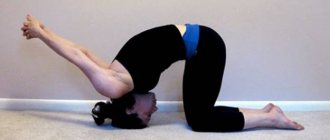Think about it and honestly tell yourself how susceptible you are to stress and how well do you deal with it? Identifying symptoms such as fatigue at the beginning of the working day, irritation, impatience, insomnia, anxiety over any little things, and anxiety in general will help clarify the answer. Do you often hear the phrase from friends and family: “It’s time for you to rest and relax,” but do not react to such remarks? If you easily recognize yourself in the previous sentences, it’s time to learn how to relieve tension through relaxation exercises.
And if this topic seems interesting to you and you want to develop even more in it, we recommend our course “Mental Self-Regulation”, where you will learn real practical techniques for self-motivation, stress management and social adaptation in order to always control your emotional and mental state. Find out more about the course
In the healthy lifestyle training, we wrote about some ways to combat the negative effects of stress that modern people are constantly exposed to in their lives. In this article, we have collected some popular techniques and exercises for relieving tension. They can easily be practiced at home, without having experience in such endeavors. The given sets of exercises are suitable for both children and adults. In addition, they are varied and based on popular breathing techniques and muscle relaxation training that are widely practiced today.
Relieving tension
For many of us, relaxation is rest at the end of a busy day. And for most people it happens the same way – in front of a TV screen or a home computer monitor. But this is far from the best way to relieve emotional stress; rather, it is a kind of illusion of relaxation. The senses remain in working order - you experience emotions, worry. From a physiological point of view, this method is not suitable for dealing with stress, because in order to fully restore mental strength, you need to activate the body’s natural relaxation reaction. There are special techniques for this (yoga, qigong, tai chi, Zen), but even without knowledge of them, you can, by devoting some free time to practice every day, learn to cope with anxiety and depression, control anger, and avoid many diseases of the cardiovascular and nervous systems. The sets of exercises given below are built taking into account accessibility and feasibility, and include elements of yoga, meditation practices, and breathing exercises. Remember that you can improve their results by using relaxation techniques along with physical exercise and ensuring proper rest through healthy sleep.
As you begin to practice various relaxation techniques, remember the following. Learning the basics of relaxation techniques is not difficult, but it does take time and some effort. Most experts recommend exercising at least 10-20 minutes a day. Those attending special sessions to relieve stress spend 30-60 minutes. Start small, and individual elements of the exercises can be performed right at your desk, in transport, at a bus stop.
Top 3 ways to relieve tension:
Complex 1. Breathing exercises
Deep breathing allows you to relax, regardless of the thoughts that overcome a person. It is not for nothing that in films, when police or doctors arrive at the scene, they advise victims to first of all breathe deeply and evenly. In stressful situations, breathing quickens and the body lacks oxygen. Deep breathing promotes the flow of this vital gas into the brain and all cells in the required volumes.
Exercises:
- Inhale and exhale slowly and deeply through your nose, counting from 1 to 4 as you inhale and exhale. This exercise is very easy to do, and it is especially effective if you cannot sleep.
- Try relaxing your shoulders and upper chest muscles as you breathe. Do this consciously with each exhalation. The fact is that in stressful situations, when a person is tense, the diaphragm muscles are not used for breathing. Their purpose is to lower the lungs down, thereby expanding the airways. When we are excited, the muscles of the upper chest and shoulders are more often used, which do not contribute to the full functioning of the respiratory organs.
- Nadi Shodhana. A yoga exercise that helps you become more active and focused; According to experts, it acts like a cup of coffee. With the thumb of your right hand, you need to close the right nostril and inhale deeply through the left (for women, use the thumb of your left hand to close the left nostril and inhale through the right). At the peak of inhalation, you need to close your left (right for women) nostril with your ring finger and exhale through your mouth.
- Sit up straight or lie on your back. Place one hand on your stomach, the other on your chest. Inhale air deeply through your nose, while the hand on your stomach should rise and the hand on your chest should move only slightly. Exhale through your mouth, while the hand on your stomach again drops, and on your chest practically does not move. In this case, breathing will occur using the diaphragm.
Relaxation exercises to relieve emotional stress. consultation on the topic
Relaxation exercises to relieve emotional stress
We are accustomed to mental and muscle tension and perceive it as a natural state, not realizing how harmful it is to health. If you do relaxation exercises with children and adults, this will help restore strength and relieve increased anxiety.
Relaxation (from Latin relaxatio - reduction of tension) is a state of relaxation, stress relief, achieved spontaneously or during special exercises.
These exercises are a universal remedy and make it possible to better concentrate after relieving tension and excitement. Having mastered relaxation, you can learn to regulate tension and relax at will. Mastering the ability of muscle relaxation has a positive effect on the formation of motor skills, improves coordination and endurance, and has a positive effect on the development of flexibility and mobility in the joints.
Relaxation exercises are best performed in a lying position and with eyes closed, since the tone of the central nervous system in this state decreases, and this creates good conditions for muscle relaxation.
Colors of rainbow.
Instructions.
Sit comfortably, relax. Close your eyes and listen to my voice. Imagine that you are relaxing on the seashore. You sunbathe lying on your back, on fine, warm sand. Your arms are so heavy that you are unable to lift them. You are relaxed, liberated, you feel free and comfortable. Your body is resting. You well.
Pay attention to the sun. It simply blinds you with red rays. You look at the sun for a long time, and it takes up all your visual space. You see nothing but this red canvas.
A small orange dot appeared in the upper right corner. You peer at it carefully, it becomes more and more, and now the orange canvas has completely covered the red color. You see a beautiful rich orange color. Against this background, the outlines of an orange pumpkin emerge.
Its color changes and it becomes yellow. This bright sunny color makes you happy. You feel the soft, gentle touch of the yellow rays. You are bathed in these warm rays. The yellow color slowly, slowly fades, turning into a delicate salad color.
The longer you look, the more saturated this color becomes. And here in front of you is a green meadow. You walk into it and feel drops of dew, the smell of grass and wildflowers.
Take a deep breath of this fresh, invigorating aroma. It makes you think about the poetic, the sublime, the unearthly.
You enjoy walking on the grass, but your gaze is distracted by a bell. So small, blue, and tender.
You love this color and you can't take your eyes off it. And this color fills your entire visual space. The blue color is getting darker and darker.
Dark blue smoothly turns into purple, which gradually goes into the distance and becomes just a horizon line.
The exercise comes to an end. On the count of three, open your eyes.
Flight
Instructions.
Sit comfortably, relax. Close your eyes and listen to my voice.
Imagine that you are in a green meadow. Above you are blue skies and warm sun. You are pleased to admire this beauty and inhale the aromas of summer grass. You feel easy and comfortable.
Imagine that you are a big beautiful bird. You rise high into the sky and soar among the airy white clouds. You fly further and further. A warm breeze blows across your wings. The movements of the wings are light and graceful. Enjoy the feeling of free and smooth flight in the air.
Now, slowly flapping your wings, approach the ground.
Try to retain the pleasant feelings that you received during the flight. The exercise comes to an end. On the count of three, open your eyes.
Walk
Instructions.
Sit comfortably, relax. Close your eyes and listen to my voice.
Imagine that you are walking through a grove. You are surrounded by the fresh smell of herbs and flowers. You can hear grasshoppers chirping, bees buzzing, and birds singing joyfully.
You feel the gentle touch of the sun's rays. The rays warm your body: arms, legs, face. One ray touched your lips and gave you a smile. You feel very warm and pleasant from these touches. You can hear the babbling of a stream nearby. You put your hands in the water and feel the coolness.
You love being in this grove. I like the blue sky, the playful rays of the sun, the aroma of flowers, the singing of birds, the murmur of water.
Admire the picture that surrounds you. All this fills you with a charge of vivacity and energy. You feel a good mood, joy of life. The exercise comes to an end. On the count of three, open your eyes.
"Balloon"
Instructions.
Take a comfortable position, close your eyes, breathe deeply and evenly. Now we will learn to relax using breathing. Imagine that you have a balloon in your stomach. You inhale slowly, deeply, deeply and feel it inflate. Now he has become big and light. When you feel that you can’t inflate it any longer, hold your breath and slowly count to yourself to five, then begin to exhale slowly and calmly. The balloon deflates...And then inflates again...Do this five to six times, then slowly open your eyes and sit quietly for one to two minutes.
Prepared by an educational psychologist:
Yarema Olga Vladimirovna
Complex 2. Muscle relaxation
The progressive muscle relaxation technique was developed by the American doctor E. Jacobson in the 1920s. It is based on a simple physiological fact: after tension of any muscle, a period of automatic relaxation begins. Taking this into account, a technique was developed according to which, in order to achieve deep relaxation of the body, you first need to strongly tense your muscles for 10-15 seconds, and then concentrate on the feeling of relaxation that arises in them for 15-20 seconds.
Exercises:
- Start by focusing on your breathing for a few minutes. Breathe slowly and calmly, think about something pleasant. After this, you can begin muscle exercises, working on different muscle groups.
- Hands.
Squeeze your hand as tightly and tightly as possible. You should feel tension in your hand and forearm. Relax your hand as you exhale, concentrating on the feeling of relief that arises. Repeat the same for the other hand. If you are right-handed, you should start with your right hand, if you are left-handed, start with your left. - Neck.
Tilt your head back, slowly turn it from side to side, then relax. Pull your shoulder joints high towards your ears and in this position tilt your chin towards your chest. - Face.
Raise your eyebrows as high as possible, open your mouth wide (as if you are pretending to be very surprised). Close your eyes tightly, frown and wrinkle your nose. Clench your jaw tightly and move the corners of your mouth back. - Breast.
Take a deep breath and hold it for a few seconds, then relax and return to normal breathing. - Back and stomach.
Tighten your abdominal muscles, squeeze your shoulder blades together and arch your back. - Legs.
Tighten the front and back muscles of your thighs, keeping your knee in a tense, bent position. Pull your foot towards you as much as possible and straighten your toes. Extend your ankle joint and flex your toes.
Do 3-4 repetitions of the complex. Each time you rest a newly tense muscle, notice how good it feels and how relaxed you feel. It helps many people cope with stress and anxiety.
Effective techniques for relaxation
Today you can find many different techniques that make it easy to quickly relax and normalize your physical and mental state. These include various auto-trainings, meditation, listening to special musical compositions and others. But often, to achieve a full effect, it really takes a lot of time, and sometimes even special knowledge and hours of practice. At the same time, there are several simple options that any beginner can master, and this will take a few minutes. We have selected four such techniques for you. And let’s say right away that to complete each of them you need to set aside 15 minutes of free time and find a place where no one and nothing will distract you during these 15 minutes.
Breathing technique
The essence of this technique is that to achieve a state of calm and relaxation, you simply breathe. Breathing, as we all know, is the basis of life, and the ability to control it is considered the first and main skill necessary to learn how to quickly relax. Conscious control of breathing distracts consciousness from thoughts, which is also expressed on the physical plane in the form of relaxation of the body muscles. Here is the breathing technique we offer:
- take a comfortable body position and start breathing through your nose;
- close your eyes and concentrate on how the air passes through your nose;
- take a deep and slow breath and try to feel the slight chill from the penetrating air;
- hold your breath for a few seconds;
- exhale calmly and try to feel that the air coming out is already warm;
- perform this sequence of actions throughout the relaxation session;
- try not to think about anything extraneous and focus on the breathing process.
Despite its apparent simplicity, this technique is very effective because... uses three powerful mechanisms. The first is that relaxation is achieved by taking a comfortable position and closing your eyes. Second, slow breathing lowers your heart rate. Third - by concentrating on the movement of air through the nose, as we said, the consciousness is distracted from all thoughts and experiences.
And one more nuance: if suddenly you need to quickly relax, but there is no way to get into a comfortable position, you can skip the first step. With practice, you will learn to disengage from what is happening and relax, even in the company of other people and under a variety of circumstances.
Progressive muscle relaxation technique
This technique was developed by the American physician Edmund Jacobson in the mid-twentieth century. He believed that if anxiety or fatigue is accompanied by muscle tension, then through muscle relaxation one can achieve calmness and allow the body to rest. When performing this technique, you will need to tense certain muscle groups. At the same time, it is important not to overstrain them, and also to ensure that the muscles of other groups are not strained. The algorithm is as follows:
- take a comfortable body position (it is recommended to sit down) and take a few calm breaths;
- clench your fists and then relax them; spread your fingers and then relax them;
- contract your biceps and then relax them; contract your triceps and then relax them;
- move your shoulders back and then relax them; push your shoulders forward and then relax them;
- turn your head all the way to the right, and then relax your neck; turn your head all the way to the left, and then relax your neck; press your chin to your chest and then relax your neck;
- open your mouth as wide as possible and then relax it; Purse your lips as tightly as possible and then relax them;
- stick your tongue out as far as possible and then relax it; pull your tongue into the larynx as much as possible, and then relax it; press your tongue to the roof of your mouth and then relax it; press your tongue to the bottom of your mouth and then relax it;
- open your eyes as wide as possible and then relax them; close your eyes as hard as you can and then relax your eyes and nose;
- take a deep breath and then get some air; breathe normally for 15 seconds; exhale all the air from your lungs, and then exhale a little more; breathe normally for 15 seconds;
- Gently bend your back forward, and then relax your back;
- pull your stomach in as much as possible and then relax it; inflate your stomach as much as possible or tense your abdominal muscles, and then relax them;
- tighten your gluteal muscles and lift your pelvis slightly, and then relax your buttock muscles;
- stretch your legs forward and lift them 15 cm from the floor, then lower your legs and relax them; press your feet firmly to the floor and then relax them;
- lift your toes up and then relax them; lift your feet up and then relax them.
Ideally, after performing this exercise, your muscles should become more relaxed than they were before, and your mind should be filled with calm and peace. If this does not happen, repeat the entire procedure. Try not to think about anything and focus only on the tension and relaxation of your muscles.
Calming Visualization Technique
Visualization is rightfully considered one of the most powerful tools for working with consciousness. According to some scientific studies, the subconscious mind does not distinguish real events from events imagined by a person. For this reason, visualized images can have a strong impact on consciousness. Follow this pattern:
- take a comfortable body position and close your eyes;
- take several deep breaths and exhalations;
- imagine that you are in a calm, quiet and pleasant place where you can easily relax (for example, on the top of a mountain, in a forest, on a beach or somewhere else);
- maintain the image you are imagining and concentrate on the feeling of relaxation and bliss, try to strengthen it and immerse yourself in it even deeper;
- detail the image, presenting it in all details (the sound of waves or birdsong, coolness or warm rays of the sun, etc.);
- when you feel that you cannot plunge deeper into the state, begin to slowly return to the real world;
- open your eyes and breathe slowly for a few minutes.
Visualization may not be easy at first, but the results will get better each time. And to achieve the desired effect faster, read our articles “Self-Teacher on Visualization”, “Seven Visualization Techniques” and “How to Develop the Power of Visualization”.
Technique for entering the alpha state
To begin with, let us recall that the human brain works in different states of attention and consciousness, i.e. at different levels. These levels are distinguished by brainwave frequencies, named for convenience by letters of the Greek alphabet. Most often you can see this classification:
- Beta waves (from 14 Hz). A state of activity characterized by wakefulness and thinking.
- Alpha waves (8 to 14 Hz). A state of relaxation, characterized by relaxation and immersion in daydreaming.
- Theta waves (4 to 8 Hz). A state of deeper relaxation suitable for meditation and hypnosis.
- Delta waves (up to 4 Hz). State of unconsciousness and deep sleep.
Scientists believe that alpha waves have the most beneficial effect on the brain and body. Therefore, they are often used in various methods of working with consciousness. Alpha activity itself can be stimulated in different ways, for example, by special audio recordings of binaural beats. But there is also the opportunity to enter the alpha state on your own.
This technique belongs to the American parapsychologist Jose Silva, and its algorithm is as follows:
- take a comfortable body position and take a few deep breaths;
- imagine the number 3 and say to yourself three times: “three”;
- imagine the number 2 and say to yourself three times: “two”;
- imagine the number 1 and say to yourself three times: “one”;
- imagine the number 10 and slowly say to yourself: “I am relaxing”;
- imagine the number 9 and slowly say to yourself: “I am calming down”;
- imagine the number 8 and slowly say to yourself: “I am relaxing more and more”;
- imagine the number 7 and slowly say to yourself: “I am calming down more and more”;
- imagine the number 6 and slowly say to yourself: “my mind is serene and clear”;
- imagine the number 5 and slowly say to yourself: “my whole body is relaxed”;
- imagine the number 4 and slowly say to yourself: “I am so relaxed that my body has become weightless”;
- imagine the number 3 and slowly say to yourself: “I am completely calm”;
- imagine the number 2 and slowly say to yourself: “I am completely relaxed”;
- imagine the number 1 and slowly say to yourself: “I am completely calm and relaxed”;
- Slowly say to yourself, “I’m in alpha.”
Of course, this technique is somewhat more complicated than the previous ones, but if you master it, you will learn to control the state and functioning of your brain and induce relaxation at any moment you need. By the way, before we move on to the next block of the article, we would like to invite you to watch this short video for deep relaxation (for the best effect, we advise you to take a comfortable body position and watch the video with headphones).
Continuing the topic of relaxation, we offer you some useful tips and recommendations, following which it will become much easier for you to learn to relax.
Complex 3. Meditation
The most general definition of the concept of “meditation” in psychological dictionaries is: “a method of mental training in which intense, penetrating reflection occurs, immersion in an object, an idea, which is achieved by concentrating on one object.” The recommendations collected in this block concern how to conduct a visual meditation session on your own. Visual meditation is a variation of traditional meditation that is based on the use of not only visual meanings, but also the senses: taste, touch, smell and sound. When used as a relaxation technique, visualization involves imagining a scene in which you feel free from tension and anxiety.
Set of exercises:
- Choose a quiet and secluded place, with nothing to distract you. Find a comfortable position. It is not recommended to lie down; it is better to sit on the floor, in a chair, or try sitting in the lotus position.
- Select a focal point. It can be internal - an imaginary scene, or external - a candle flame. Therefore, the eyes can be open or closed. At the beginning, it is very difficult to concentrate and avoid distracting thoughts, so the focus point should have a strong meaning, understandable and clear, so that you can return to it at any time.
- The focal point should definitely be something calming for you. It could be a tropical beach at sunset, a forest clearing, or an orchard in a village near your grandparents’ house, where you visited as a child. Visual meditation can be done in silence, or you can turn on relaxing music or an audio recording with meditation tips.
- Try to use all your senses as much as possible. For example, your focal point is a forest. Imagine that you are walking through a clearing, and cold dew falls on your feet, you hear the singing of many birds, smell the pine, breathe in the clean air deeply. The picture should be as lively as possible. Meditate for 15-20 minutes.
Remember, relaxation will not save you from problems, but it will help you relax and distract yourself from unimportant details, so that later you can tackle the solution with renewed vigor.
Reviews and comments
You can express your opinion about the article, relaxation exercises, as well as share your own knowledge on the topic and experience, using the comment form.
We also recommend reading:
- Storytelling
- Muscle relaxation: relaxation techniques
- What to do with psychological problems?
- 10 Popular Exercises to Relieve Stress
- Anger management: a selection of useful materials
- How to manage anger?
- How to learn to relax: effective relaxation techniques
- Methods of mental self-regulation: save yourself
- Is it hard to be a yogi?
- To breathe or not to breathe?
- Stress Diary
Key words:1Psychoregulation
Relaxation tips
To begin with, here are a few more examples of effective relaxation exercises related to breathing and muscle function.
Simple exercises for relaxation
As we have already said, when the human body is in a stressful and tense state, its pulse and breathing increase. This mechanism is necessary for intensive saturation of cells with oxygen, but this does not always have a positive effect on the physical and mental state. It will be much better if you learn to breathe deeply and calmly. And here are some exercises for this:
- Slowly inhale air through your nose and exhale through your mouth. Inhalation should be done in four counts, and exhalation in two counts. You need to do 10 repetitions.
- Do the previous exercise, but concentrate not only on the count, but also try to relax the muscles of the chest and shoulder girdle. Due to the fact that the diaphragm is used in breathing, it will become deeper. For one approach, 10 repetitions are enough.
- Lie down on a bed or sofa and place one hand on your stomach. Inhale air so that your hand is pushed up through your stomach. Keep in mind that you need to breathe through your mouth. Do 10 reps.
When it comes to muscle relaxation specifically, learning to do it on your own will help you rest and recover quickly. A few exercises on this topic:
- Lie on your back on a bed or sofa with your legs straight. Slowly raise your arms up, and then spread them to the sides and lower them. Try to relax as much as possible for 15-20 seconds. Breathe as deeply as possible. The exercise must be repeated 5 times.
- Take the same body position. Lying on your back, slowly pull your knees bent to your chest one by one. Then stretch them out and try to relax as much as possible for 15-20 seconds. The exercise must be repeated 5 times.
- Lie on your stomach. Extend your arms along your body. Slowly raise your shoulders and head and stretch forward a little. Then return to your original body position and try to relax as much as possible for 15-20 seconds. Repeat the exercise 5 times.
- Stand with your feet shoulder-width apart. Clench your fists and raise your arms up. Tighten your entire body, and then suddenly relax, allowing your arms to fall down. Stay in a relaxed state for 15-20 seconds. Repeat the exercise 5 times.
Now let’s move a little away from techniques and exercises, and let’s talk a little about proper nutrition, or rather about foods, the use of which helps relieve tension.
Stress Relief Products
Nutrition is one of the main components of human life, because together with food, all the necessary vitamins, nutrients and microelements enter the body. And if a person eats right (by the way, we have good material on the topic of proper nutrition), then it is much easier for his body to cope with tension and stress, and it is much easier for the person himself to relax and rest faster. To increase your body's resistance to negative external influences, try to follow these simple nutrition tips:
- Make sure you have fresh fruits and vegetables in your diet. This is “live” food that has a beneficial effect on the nervous system and the body as a whole.
- Include fish in your diet. It contains iodine and phosphorus. The first promotes muscle relaxation, and the second helps maintain normal hormonal levels.
- Eat more millet and buckwheat porridge, nuts and legumes. All of these products contain magnesium, a natural antidepressant.
- Eat apricots, rye bread, dairy and offal. They contain large quantities of B vitamins, which increase resistance to stress and stabilize the activity of the central nervous system.
- Don't forget to eat potatoes, sweet fruits and honey. They are a source of glucose, the deficiency of which causes nervousness and tension.
- Drink green and herbal teas. They are rich in antioxidants that remove harmful substances and toxins from the body. The cleaner the body, the easier it is to endure stress and restore strength.
Also, take note of this small list of products that help calm your nerves, relieve tension and increase your body’s resistance to stress:
- strawberries, raspberries and blueberries (contain natural antioxidants and vitamin C);
- cereals and grains (help the body produce serotonin);
- Brazil nuts (contain selenium, which has sedative properties);
- spinach (contains vitamin K, which synthesizes hormones that are responsible for stress resistance and good mood);
- apples (rich in vitamin C, iron and fiber);
- dark chocolate (contains anandamine, which causes a feeling of calm and relaxation);
- bananas (contain vitamin B, potassium and magnesium).
And in addition to all of the above, here are a few more life tips that will help you strengthen your nerves and help you cope better with stress.
How to calm down easily
These simple steps should be performed any time you feel nervous, physically or emotionally tired, exhausted, or under stress:
- Change your activity . If, for example, you sat at the computer for a long time or wrote a report, do some physical activity: walk, go to the store, do a warm-up, etc. This will help you take your mind off the monotonous and routine work.
- Go out into the fresh air and breathe a little . Your blood will become more oxygenated, which in turn will make you calmer.
- Drink some water . Remember that even mild dehydration can cause irritability, confusion, and mood swings.
- Listen to calm music . It has a wonderful effect on the psyche: it calms the nerves, promotes inner harmony and relaxation.
- Light the aroma lamp . Essential oils of jasmine, chamomile or bergamot mixed with water and heated with a candle will easily calm the nerves and restore vitality.
- Look at the nice images . If you look at a photo or video of space, mountains or the ocean for at least 5 minutes, you can quickly relax and calm your racing thoughts.
- Get out into nature . The beauty of Mother Earth and fresh air are one of the best means for relaxation, relieving stress and putting your inner world in order.
- Go to the bath, shower, pool or sauna . Water relieves fatigue better than other remedies and takes away negative energy. It is especially useful to swim in a river or sea, i.e. where the water is not stagnant, but constantly renewed.
- Go for a massage . A specialist will help your muscles relax and your body to produce serotonin, which in itself will weaken the effect of emotional stress. By the way, you can ask someone at home to give you a massage, or you can do it yourself - massage those areas of the body where your hands can reach.
- Get creative . By creating something with your own hands, you create the perfect environment to reduce anxiety and stress. You can just as easily go to the cinema or theater, visit a museum or art gallery.
- Start meditating daily for at least half an hour a day . This activity is great for calming thoughts and achieving inner harmony, with long-term effects. We have a guide to meditation and relaxation on our website.
- Limit your consumption of coffee and alcohol, as well as smoking cigarettes . All this not only dehydrates the body, but also increases fatigue and susceptibility to stress (and this is not counting the well-known facts about the dangers of coffee, alcohol and nicotine).
We also advise you to always consider any events that occur objectively, i.e. not only from my point of view, but in general. All problems can be resolved. What seems difficult or unfair now may well lead to better consequences in the future. Therefore, you need to look at everything from different sides, and also not take anything to heart.
As you can see, learning to relax and rest quickly is not that difficult. Remember that there are two fundamental factors here - your desire and knowledge of certain techniques. If you decide to read this article, then you already have the desire, and if you have finished reading it, then the techniques are now at your disposal.
And in conclusion, we bring to your attention another video on the topic of relaxation. Save it to your playlist or browser bookmarks and watch and listen (preferably with headphones) when you want to relax and calm your inner world.
We wish you a good mood and a positive attitude every day!
We also recommend reading:
- Storytelling
- A short guide to developing concentration
- 10 Popular Exercises to Relieve Stress
- Breathing and thinking: a way to calm down in a stressful situation
- Methods of mental self-regulation
- Muscle relaxation: relaxation techniques
- To breathe or not to breathe?
- Rebirthing: being reborn through breathing
- Ways to fall asleep faster
- How to manage anger?
- How to learn to meditate: in accessible language about the most important things
Key words:_D1036, 1Psychoregulation, 4Psychoregulation










